Hercules’ Club: Zanthoxylum Clava-Herculis
I sometimes feel sorry for my neighbors, who have lawns of decapitated grass. I’m sure my wild-looking but well-planned yard bothers them but I have the yard of the future, and they of the past.
When I moved into this cul-de-sac house a dozen years ago, it was 1960s suburbanized, read lots of august Augustine lawn, obligatory dwarf legustrums, sago palms (cockroach high rises) and no privet privacy. Since then I’ve managed to get rid of most of the lawn and standard drudgery shrubbery. In their place is an edible landscape, including numerous trees. Every bit of green I’ve planted is consumable in some way, from Amaranth to Zanthoxylum, the latter a magnificent Hercules Club, now some 30 feet high.
The full botanical name for the Hercules Club is Zanthoxylum clava-herculis, which in bastardized Greek — my term for Latin — means “yellow wood club of Hercules.” The roots of The Club are indeed yellow but very weak, not at all Herculean. They are easily broken by hand. Quite odorous, they also appear to be barkless. The “clava” part, the club, comes from Hercules’ weapon of choice, a club that grew spikes, and the Zanthoxylum has spikes: All over its trunk and branches. Mythology aside, The Club has been used to treat toothaches for thousands of years, with a natural kind of topical novacaine found in all parts to varying degrees. The Club also has chelerythrine, which in the lab is effective against resistant staphylococcus, a little nasty bug one picks up in hospitals.
American natives used The Club, for a range of ailments. A bark decoction was used for venereal disease; the bark, wood and leaves for toothaches, and a decoction of boiled roots was also used to increase perspiration. Indians and settlers mixed the inner bark with bear fat and used it as a poultice for ulcers and a treatment for itches. Ripe berries were seeped in hot water to make a spray used in the mouth and blown on the chest and throat for chest ailments. The bark was also used for inflammations of the throat.
What its leaves, bark and roots, taste and smell like is a matter of subjective debate. Some say its smells like lime, others bitter lime. To me it smells just like Ambersol, the toothache application you can buy in drug stores…or …Anbesol smells like The Club. The tree is also covered with thorns which means kids and other climbing animals leave it alone. One creature, however, that is not deterred by the thorns is the the larvae of the giant swallowtail butterfly (Papilio cresphontes). All stages of the caterpillar like the tree. The Club
blooms in early spring. In fact, as I write it is late February and it is readying to blossom. Each tiny flower turns into a fruit that dries and splits to reveal a shiny black seed, see photo upper right. Some folks use the seeds of closely related species, the Prickly Ash (Z. americanum) like hot peppercorns, and some think the seeds from The Club can be used the same way. Personally I don’t think so. Z. clava-herculis
seeds taste medicinal to me, not peppery. I also boiled and dried them as recommend. Again mildly medicinal, no pepper. Some however, heat the seeds in salt then use the salt and seeds as a dipping material.
Surprisingly, The Club is cousin to the non-native citrus. Small world. My particular tree has travelled quite a lot. It was first rescued as a sapling from a bull dozer in Daytona Beach in the early ’90s, Port Orange to be specific. It then spent a few years in Lake Mary, Fl., and a clone from that tree is now in Maitland, some 70 miles from where it started. One doesn’t see them too often but when you do there are usually several around, like a dispersed colony. The national champion is 7.5 feet around, 38 feet high, and currently residing in Little Rock, Ar., USA. Its name is said: zan-THOCK-sill-lum CLAY-va-her-KEW-lis.
Incidentally, if you live in The South there is a grass that can also ease the pain of a toothache, Florida Orangegrass, Ctenium floridanum. (TEN-ee-um flor-re-DAY-um, from the Greek xteni, hah-TEN-nee, meaning comb, read all the seed heads on one side.)
My Club shades my Florida Room, below, which has a trash-bin granite floor ( notice my helper, Oliver Whitecat, in the chair.) Tons of broken and end-pieces granite are thrown away every day. All one has to do is a little dumpster diving to get it. In this case a few early Sunday mornings. Not only do I have a granite floor, but four walkways as well. Now that’s recycling!
One last thing: It is related to Szechuan pepper.
Green Deane’s “Itemized” Plant Profile
IDENTIFICATION: Young growth covered with spikes, leaves alternate, pinnately compound, 7-9 narrowly elliptical to lanceolate leaflets with round-pointed teeth, waxy-shiny above, light green below, 5-8 inches overall
TIME OF YEAR: Inner bark available year round, leaves except for winter. Seeds, summer.
ENVIRONMENT: Well-drained, dry sandy spots, full sun to some shade.
METHOD OF PREPARATION: Leaves and inner bark for topical use against toothaches. Fruit might be used like pepper but this is not an endorsement of that practice. Some heat the seeds in salt (in the oven) and use the mix as a dipping material (like a sauce.) A potentially toxic tree, approach accordingly.

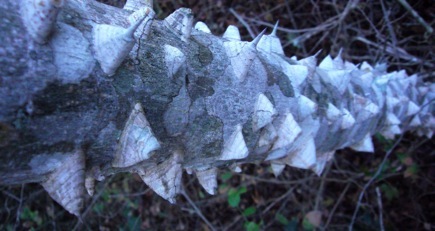
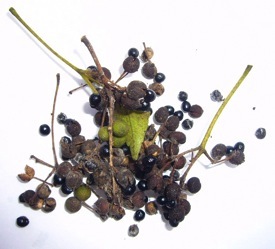
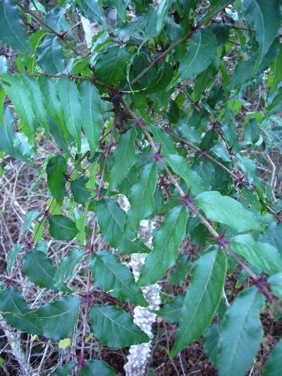
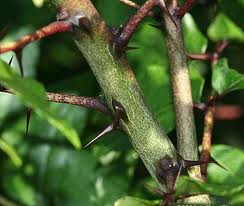
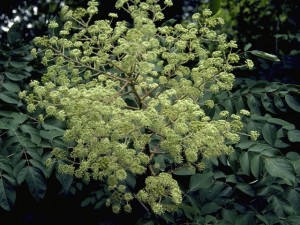
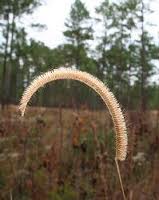
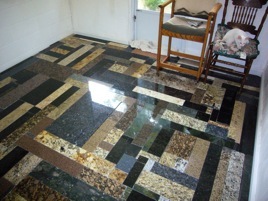

WE also call it ‘Tickle Tongue Tree’ because leaves and bark will numb the mouth and tongue. I read where sailors carried a little bit of the dried inner bark on long voyages in case of toothache. They’re found growing in old fence rows and at the edges of old pastures along with ‘bodark’ or Bois de Arc (or horse apple) trees.
There are several out in the fields where Grand dad had his pastures divided and we have 2 here in the yard. When the leaves come out there is a little black bug that will devour the lower branches. Doesn’t seem to hurt the tree, but it makes an ugly tree even uglier.
OH, your Florida Room floor is lovely!!
mew
I think we have this tree/ shrub in the back yard I’ve been trying to identify what it is.I haven’t seen one bigger than about ten feet or so but it is covered in thorns the thorns are based from the leaves but are also random on older branches. it has stout branches and its growing in sugar sand. the leaves are also shorter and round. is there different varieties of the plant that come to mind that I could look up to see what this tree is? the dead branches that fall off will pierce right through a flip flop! I figured you would know cause your in Florida and teach classes in south Florida.
Where can this Hercules Club be purchased? I live in Michigan and don’t know if it would survive the cold here? Interesting reading
We have several of these trees on our farm, always along fence lines. You want to be very careful when pruning them as the thorns can literally rip your arms to pieces! An interesting tree and it emits a very strong odor when the leaves are crushed or you break the bark.
CAN ZANTHOXYLUM CLAVIS HERCULIS BE USED FOR TREATING ARTHRITIS & EOSNOPHILIS. TWO SEPERATE PEOPLE?
I have one reference to it being used to treat rheumatism.
My husband found one of these trees on our farm last year and thought is was an Elderberry. I made jam from the berries. I ate three jars of it during the winter, and it didn’t seem to bother me. We just found out by seeing the stickers on the trunk and between each leaf branch that it was a Hercules Club instead. Some sites say it’s really poisonous. But if it were, wouldn’t I have died or got sick from eating it in such a concentrated form?
The berries are used as a spice. As jelly is mostly sugar and water perhaps that moderated the effects (and flavor.)
Husks are around the seeds.
We have a lot of this intriguing tree (Southern Prickly Ash) on the ranch where I live. What is the best way to harvest the inner bark? I want to avoid the thorns when I try to get some plant material to use. Can anyone give me step by step instructions for making preparations from the leaves, bark, and/or roots?
Also, does anyone know where I can find toothache grass? I have not seen any in years. It is a very interesting grass, and I would like to have some.
All you need is a small strip of bark to put in the mouth. As far as toothache grass goes I think it is rare or endangered. I mention in one of my articles.
Back around Halloween I found something in this family recently up in our part of Western N.Y. Little bit south of Buffalo near Lake Erie. Never having seen it before I was at first hoping it was some monster elderberries till I got close enough to see the thorns & other details. Looking at the usual regions I’m surprised it’s up here I wonder if it’s a new arrival. Any idea which type is the most cold tolerant & likely to be up here in the frozen North? Other odballs hanging out too far north that I’ve been lucky enough to spot lately include one little sassafrass tree & one persimmon (fruits not worth a darn likely to short a growing season.)
Might be prickly ash…
eureka !! i finally found out what this tree is. i have 2 with new ones spring forth every year. very pungent aroma, but i love it. fascinating to see in person. the birds love the seeds or dry berries. it has a moist husk that dries to produce a black seed. yes? i was told it was the ” Devils Walking Stick” by an arborist. Little did he know. a conversation piece for sure.
Steve
Do you have to have a male and female plant? Gifted one by Andy Firk and waiting to put it in the ground.
I’m so confused. My “Field Guide to Trees and Scrubs By George Petrides 1972 edition p. 128-9 lists Hercules-Club as Aralia spinosa and Southern Prickly-Ash as Zanthoxylum Clava-Herculis. According to the book you have two different plants. We have both here in the Arkansas river valley. I have never seen a Hercules-Club larger than a few inches around, it stays small and spindley most less than 15 feet tall . The Southern Prickly-Ash tree out my window is over 5 times around of the Hercules-Club and over 20 feet tall.
Am I wrong? What reference are you using?
Common terms can be easily misplaced. As long as one can ID the tree with the right botanical name things are fine.
Love this tree!! There are a few in the woods here in central Florida. How can I propagate ? Or when and how can I get seeds?
It’s really quite common. I would dig up and plant or pot a seedling.
I had a cluster in my Port Orange yard, couldn’t identify and removed them! They cut up my diabetic husband. Searched out replacement for years. Finally have one, small, and want to succeed in growing it this time. Please advise location, as old location not possible. My yard soil seems to be replaced by the builder, so not native soil unfortunately. Very dry. Should I try to amend the soil? Moisture needed, or just standard waterings? I hope to cultivate enough to place in more than one area. I want to see if they can go to the Keys, too. I have a friend I would gift. Comments say this is common, but I haven’t seen any around here, Daytona areas. I would have dug them, this is the third time I’ve purchased expensive specimens. I hope I am successful this time! Thanks!
Have you ever tasted Sichuan peppercorns, to your knowledge? The flavor is nothing like pepper. There are two main varieties I believe, red and green; the green Sichuan ‘peppercorns’ have a very strong medicinal smell (and taste), while the red are floral and fruity. From what you’ve described, it sounds like Hercules Club may be an acceptable substitute, for the green at least. I guess I need to take a trip into Hercules Club country to find out for myself.
good nose! sichaun peppercorns are actually the fruit of some kind of prickly ash. i actually just came to this blog because i found that out, but i want to do more digging and find out which prickly ash it is.
Oh my goodness, I love your patchwork scrap granite floor! What a wonderful idea for upcycling, and a beautiful result!
Will you please tell me how you installed the granite? Did you use adhesive and grout like for ceramic tile?
I first completed the patchwork, all the pieces. Then I lightly cemented them down. As the edges were so well cut i didn’t have a need for grout but if I did white sand would have been my choice.